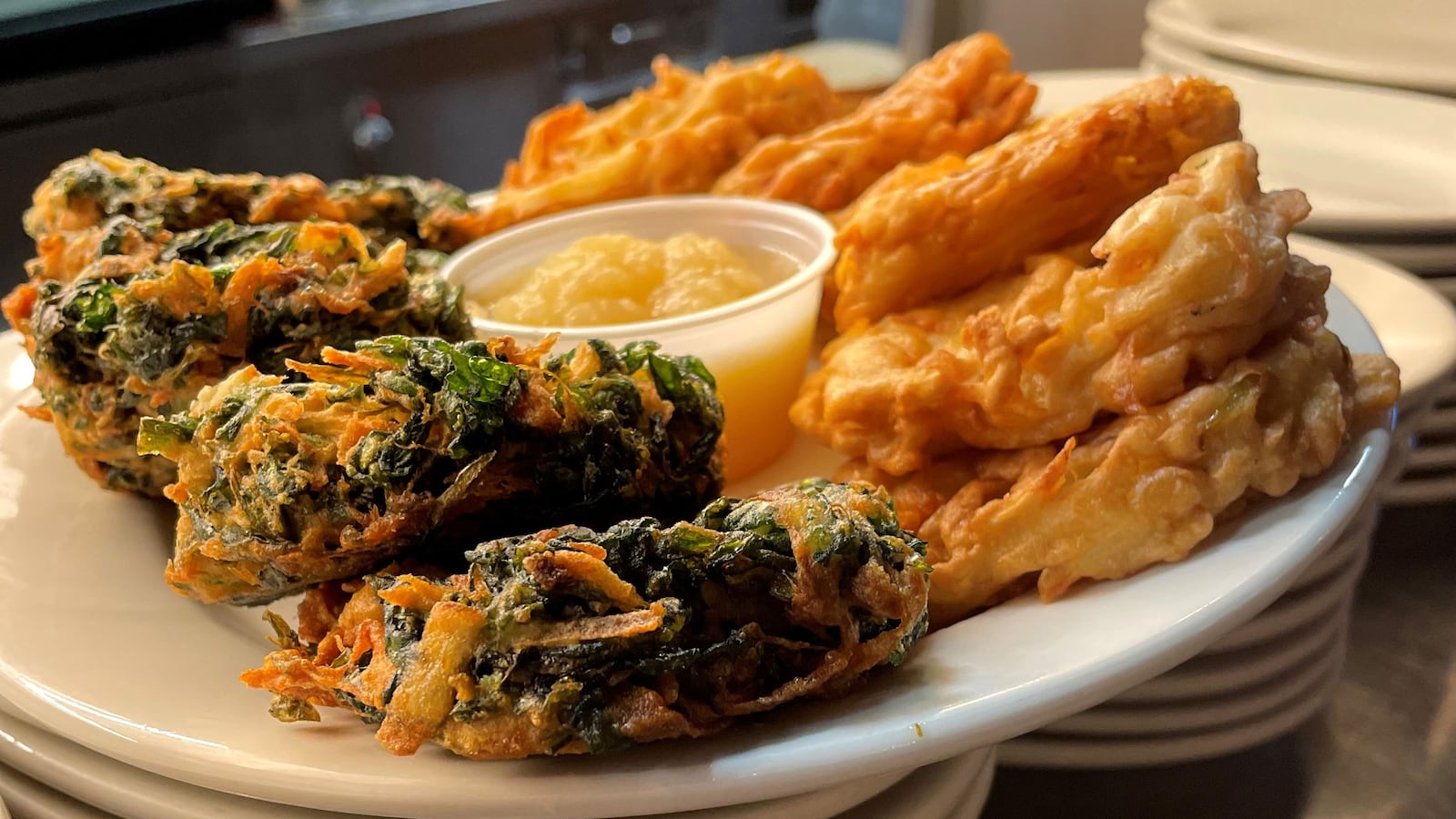The Jewish festival of Hanukkah is synonymous with many things nonedible: the menorah, spinning dreidels, the number eight, iconic folk songs, unusually long-burning oil, and, of course, the rededication of the Second Temple at Jerusalem during the Maccabean uprising against a Hellenistic empire.
But for many Jews, it’s all about the food.
Aside from the usual holiday staples like matzo ball soup, brisket, roasted chicken, and challah bread, Hanukkah prominently features oily fried treats—most famously the deliciously crispy potato latke.
It might as well be hard-wired into Ashkenazi Jewish genes that every family must have its own latke recipe. Some make the dish like a crispy hash brown patty, others (like mine) opt for more of a pancake-like consistency; some use russet potatoes, others use Yukon gold; some fry in vegetable oils, others insist upon schmaltz (rendered poultry fat); some season with salt and pepper, others get creative by adding sugar and spice (or an even more radical thought: Sichuan peppercorn).
Try as we all might, few latkes are as consistently golden brown and crispy-as-all-get-out but delightfully chewy as those made by Ben’s Deli, a chain of kosher-style restaurants that will soon enter its 50th year slinging comfort food for ravenous New Yorkers.
But Ben’s classic take on the potato pancake isn’t based on some centuries-old, misty-eyed familial link to the old country.
“I wasn’t happy with the way the potato latkes were being made,” Ben’s Deli founder and owner Ronnie Dragoon explained to me. “So, this was no long-lost recipe nor was it my late mother’s recipe but, rather, I wanted it to be the best commercial potato latkes.”
If you’re a Jewish person (or just a deli enthusiast) with roots in New York, or more especially, the Long Island suburbs, odds are that Ben’s holds a nostalgic place in your life.
The chain’s signature neon red logo, art-deco dining rooms, caricature artwork of Dragoon, and gag gifts (e.g., a T-shirt with a Ben’s beef salami stick, captioned “The Longer It Hangs... The Better It Tastes”) have graced its many locations throughout the area. The chain’s heaping platters of sliced deli meats, rye bread, pickles, and coleslaw have been served at many a bris, baby naming, shiva, synagogue function, or miscellaneous social gathering.
When Ben’s first opened it was a fixture among first- or second-generation Jewish American families in the area, serving as a reliable meet-up spot after shul on the weekends. “People would move to other tables to say hi to other congregants,” Dragoon reminisced.
But as time went on and as food trends continued to move away from the salty or fried, classic Jewish-style delis often have become more like a novelty. Or worse: many of these have establishments have closed, following the sad fate of the tri-state area’s vanishing diners.
“Every generation removed from the immigrant experience is less loyal to the kosher deli,” Dragoon lamented. “There used to be one to two kosher delis in every Jewish town on Long Island. Now, you can’t find them.”
Ben’s Deli has, indeed, lost a few locations over the years—including its founding spot on the South Shore—but at the half-century mark, it still dots the island with three locations, in addition to a Manhattan spot that replaced Garment District institution Lou G. Siegel’s deli after an eight-decade run, a Queens dining room, and an outpost in Boca Raton, where many loyal patrons of yesteryear have made their migratory retirement.
But Ben’s has carried on, Dragoon said, and it may be thanks in part to the brand’s relentless efforts to adapt. Of particular pride to the Ben’s Deli proprietor in our conversation was the addition of his plant-based and dietary menus. And over the years, the family-owned chain has also introduced a selection of new paninis, wraps, specialty burgers and the holiday option to have your latkes made with some “healthier” flavors like spinach or sweet potato.

But the stars of the Ben’s Deli show are—and forever will be—the Jewish must-haves. The matzo ball soup. The house-cured meats like corned beef, tongue, and pastrami. The “Jewish peasant dishes,” as Dragoon described them: beef flanken in the pot (a kitchen sink chicken soup with matzo ball, kreplach, peas, carrots, and boiled fall-off-the-bone fatty short rib; also my go-to order since I was teen), stuffed derma (a savory animal fat-and-matzo-meal sausage-like concoction), traditional goulash, baked potato knish, chopped liver, kasha varnishkes (buckwheat groats with bowtie noodles, often served with gravy), and gefilte fish (if you don’t already know, you probably won’t want to know).
And, of course, the latkes.
Dragoon said he has continuously toyed with the recipe over the years, including using monthly deli managers’ meetings to “make certain we’re doing the best of the breed,” tweaking the formula based on an individual deli’s improvements on the quality.
While Ben’s latkes may not be based on a specific family recipe, their genesis is rooted in mimicking the homemade techniques—but adapted to scale. When self-described “young pup” Dragoon founded his first restaurant in 1972, he recalled, his Jewish deli peers were running their potatoes through a large grinder. “Potato pancakes should be shredded on the ‘knuckle buster,’” he said, referring to every home cook’s experience with bloodied hands while scraping the last nub of a potato on a surprisingly sharp old-school box grater. “And so I got a machine that did that. Because the potato flavor, when you grind it, is not the same flavor as when you shred it.”
And so that’s what made the latkes a success, Dragoon said—one that has drawn the attention of other esteemed delicatessens.
“The owners of the world-famous Carnegie Deli called me and said Ben’s potato latkes were better than theirs, so could I do them a favor and show them. And show them I did, and they were ecstatic,” he boasted. “I never minded spreading the gospel of excellence, even to competitors!”
INGREDIENTS
- 3 lb (9 medium) White all-purpose potatoes, peeled
- .5 lb (1 large) Yellow onion
- 3 Large eggs
- 1.75 tsp Kosher salt
- .25 tsp Ground nutmeg
- .25 tsp Ground white pepper
- 1 cup Flour
- Oil
- Apple sauce, for dipping
DIRECTIONS
- Shred the potatoes and place them in a bowl filled with cold water. Shred the onion. Add the potatoes and onions to a colander and drain well, pressing to release all the liquid.
- In a large bowl, whisk together the eggs, salt, nutmeg and pepper. Add the potatoes and onion to the egg mixture. Stir to combine. Add the flour and stir to combine well.
- Heat 1 inch deep of oil in a large heavy skillet. Using an ice cream scoop, scoop a generous half cup of the potato mixture into the hot oil. Using the back side of the ice cream scoop, flatten the potato mixture to three quarters of an inch thick. Cook, turning the latke over halfway through the cook time, until golden brown on both sides and cooked in the center.
- Remove the latke and place on paper towel to remove the excess oil. Serve with applesauce.
- Makes 10 servings.






